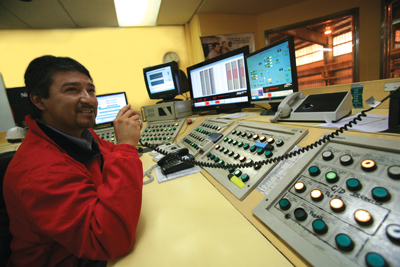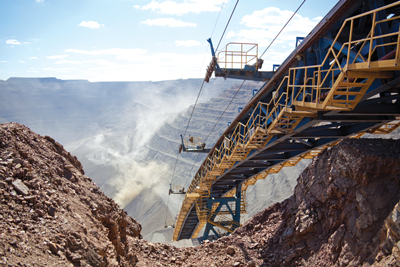Conveyor systems, integral to operations, require conditioning monitoring to ensure uptime
By Todd Schools
 |
| Conveyors can replace haul trucks for delivering ore to the process plant in certain instances, but a breakdown can bring production to a halt. Condition monitoring is essential to keep operations functioning smoothly. |
Increasing reliability and lowering maintenance costs are key differentiators in today’s highly competitive mining environment. Understanding mine equipment criticality and failure shows where maintenance effort should be focused to mitigate risk. One of the areas of focus based on criticality is conveying systems. These conveyors are typically single points of failure and, therefore, have high criticalities. The conveying system’s multiple rotating components, length and remoteness increase the complexity of maintaining these systems. A dedicated condition monitoring system can dramatically increase the reliability of a site’s conveyors.
The higher volume and lower recovery rates from low grade ores put added stress on a mine’s physical equipment. From getting ore out of the ground to getting it to the processing plant, there is risk of equipment failure in this punishing environment. Conveyors, trucks or a combination of the two are deployed depending on whether the operation is surface or underground and on its proximity to the plant. As mines are constructed in more remote locations, the processing plant is often far away from the pit, a trend that exacerbates the risk of equipment breakdown. Conveyors can replace haul trucks in certain instances, but a breakdown can bring production to a halt. Operations that depend on very long and critical conveyors find that backup solutions to unplanned conveyor downtime are costly, inefficient or nonexistent. For these critical pieces of equipment, risk mitigation is a must.
When conveyor operations are closely monitored, it’s possible to predict mechanical failures before they occur. In fact, recent studies indicate up to 90% of machinery malfunctions are predictable. In many cases, maintenance can be performed online without any interruption in service. Even in cases where the belt conveyor system must be taken offline to make repairs, the required maintenance can be planned to coincide with scheduled downtime, which will greatly reduce its production impact and cost.
Effectively monitoring belt conveyor systems in open-pit mines ensures maximum uptime by employing specialized condition monitoring systems to maintain machinery health. Online condition monitoring of conveyers supplies real-time machinery health information back to the control room and maintenance shop. Successful implementation of condition monitoring provides high reliability, improved safety, minimized maintenance costs and improved operations.
BELT CONVEYORS IN OPEN-PIT MINING APPLICATIONS
Conveyor systems that move heavy and bulky substances such as mined materials necessarily operate at low speeds to accommodate high loading. These types of belt conveyors come in various configurations, but all share certain characteristics that make them suitable for condition monitoring.
Belt conveyor systems generate certain and predictable vibration signatures when operating correctly at various speeds and loading. These vibrations are primarily produced by motors, gearboxes, idlers, pulleys and other mechanical devices used to translate the constant rotational energy of the motors to the varying linear energy required for conveyor operation.
While vibration data collected using route-based vibration analyzers is accurate and may be valuable, it has drawbacks in a mining environment. Certainly there are safety concerns when sending personnel out to collect the data using route-based systems. Additionally, there is lack of real-time, constant visibility to developing equipment problems.
An online condition monitoring system, connected to vibration sensors located at various points along the belt conveyor system, delivers continuous data to keep the conveyer operating and to provide constant understanding of asset health. Only the most critical components, such as large motors, gearboxes, important roller bearings, and main idlers and pulleys are monitored; it’s not cost effective to monitor minor components such as all of the idlers installed in a series configuration.
 |
| A condition monitoring system is often used to predict failures of belt conveyor system components such as major drives, idlers and pulleys. |
SENSOR SPECIFICS
Vibration is the most important parameter for condition monitoring, with temperature also measured in some instances, particularly for sections of a conveyor system installed in a controlled environment such as a building. For outdoor conveyor sections, temperature varies widely based on ambient conditions, making it a poor indicator of machinery health. Motor current signature analysis is also employed on key motors in some rare situations.
Vibration sensors are of the accelerometer type, with a typical output of 100 mV/g of acceleration. Temperature sensors are generally RTDs, either built into the accelerometer or external. Both sensor types are usually hardwired back to the condition monitoring system inputs.
In recent years, wireless sensors have become practical in some applications and are being adopted in the industry. Both the tensioning pulley, because it travels, making hardwiring problematic, and the tail pulley, which is often located a long distance from the other sensors, are good applications for wireless monitoring. Wireless vibration measurement is achieved by installing a wireless transmitter in close proximity to the sensor. The transmitter receives the mV signal from the sensor and transmits a wireless signal to a repeater point or directly to the base station. The base station receives the wireless signal and outputs an appropriate value to the nearby condition monitoring system.
The condition monitoring system has input modules that are connected directly to the vibration and temperature sensors via hardwiring. If wireless is employed, the condition monitoring system is hardwired to the base station, typically via a digital data link.
 |
| PCs running condition monitoring software are usually located in the mine’s central and typically connected to the mine’s automation system. |
CONDITION MONITORING SYSTEM DETAILS
The condition monitoring system has two main components: input cards installed in a chassis and one or more PCs running the condition monitoring software. The chassis is typically connected to the PCs via a hardwired digital data link.
The PC, usually located in the mine’s central control room, is also typically connected to the mine’s automation system and to related PC-based software applications such as a data historian or an asset management system. All of these connections are generally via hardwired digital data links, often Ethernet-based. The connection from the chassis to the PC is often redundant to increase uptime and ensure availability.
The mine’s automation system will include some type of human-machine interface (HMI), which normally consists of a number of PCs and monitors that present graphical representations of mine operation to operators and engineers. The HMI system will also allow mine personnel to control mine operation as required.
The condition monitoring system’s PC-based monitor presents detailed information of the conveyor system status to mining operations personnel. Because the condition monitoring system is also typically linked to the mine automation system’s HMIs, plant personnel can see overview data that can indicate the necessity to view more detailed data at the condition monitoring system’s PC screens.
The condition monitoring system does much more than just read sensor inputs and display data; it also contains sophisticated software that allows failures to be predicted long before they might otherwise occur so that corrective action can be taken.
Most automation systems have the ability to monitor sensors and other inputs and to display data from these inputs on HMI screens in various graphical formats. Automation systems can also be configured to flag input data with an alarm when readings are abnormal and to display alarm data.
Condition monitoring systems provide additional information to operations and maintenance personnel by examining input data in much greater detail, often using advanced analysis methods to make sense of the data, allowing predictions to be made concerning operation of the monitored system.
For example, one innovative condition monitoring system employs a technique called peak value analysis that’s specifically programmed for early detection of failures in belt conveyor systems. Unique algorithms allow observation of peak values over sequential discrete time intervals. These values are captured and analyzed in terms of peak values, spectra computed from the peak value time waveform, and the autocorrelation coefficient computed from the peak value time waveform.
Another feature employed by leading condition monitoring systems is adaptive monitoring that normalizes vibration data based on conveyor belt speed, typically inferred from the speed of the head pulley.
An increase in vibration isn’t necessarily a cause for alarm; it may be perfectly normal for vibration to increase when speed increases, but only to a degree. Adaptive monitoring allows adjustment of the monitoring strategy based on changing process conditions such as speed.
The condition monitoring system may also allow for the simultaneous display of multiple trend windows for a vibration—one for 100% load and one for 110% load—each with independent analysis and alerts.
 |
| Belt conveyor systems come in various configurations, but all are suitable for condition monitoring. |
Because the condition monitoring system is so critical to maintaining the operation of the belt conveying system, it often contains certain self-monitoring features. For example, the condition monitoring system can prevent missed trips by using module self-health checking and instrumentation health monitoring, along with hot swappable, external and redundant power supplies.
False trips can be addressed through features such as 2oo3 voting logic for increased decision accuracy, and by using two-channel modules so that swapping a module will never affect more than two channels.
CONDITION MONITORING IN ACTION
An open-pit copper mine owned by a major producer has one five-mile-long belt conveyor that moves ore from the in-pit crusher to the concentrating plant. This mine extracts approximately $320,000 per hour in copper and molybdenum from 12.5 million lb of ore.
Mechanical breakdowns of this belt conveyor were causing significant disruptions to the mine’s production. Replacing one of the many conveyor drive train components, like a gearbox, could result in an eight-hour outage, costing more than $2.5 million in lost production.
Manual monthly vibration readings on the conveyor’s major components weren’t able to predict failures that impacted production like tooth damage and bearing failure, so the site switched to an online condition monitoring system.
The condition monitoring system now generates early warnings of incipient conveyor drive system mechanical failures using its unique peak value analysis algorithms. Through predictive data, the mine has put a program in place so most impending failures are serviced during scheduled conveyor maintenance outages, allowing drive problems to be taken care of before they develop into catastrophic events.
To ensure timely replacement of conveyor drive system components, the mine has developed complete and pre-aligned skid mounted drives, allowing them to exchange the entire conveyor pulley drive system when any conveyor drive component is in a predicted failure mode. The condition monitoring system and the plant maintenance program ensure that all components are maintained and aligned as needed, greatly reducing downtime and extending component life.
A belt conveyor system in an open-pit mine has many advantages over trucks, but only if it’s highly reliable with little or no downtime, as the conveyor system represents a single point of failure for the entire mine operation. A sophisticated condition monitoring system will allow uninterrupted operation of the belt conveyor system through advanced analysis of vibration data, making belt conveyor systems a viable alternative to trucks in many open-pit mines.
Todd Schools is global industry solution manager at Emerson Process Management









